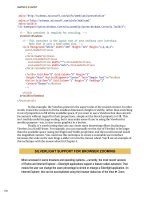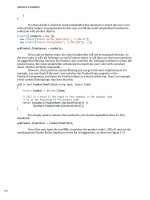Apress Pro Apache Struts with Ajax phần 4 potx
Bạn đang xem bản rút gọn của tài liệu. Xem và tải ngay bản đầy đủ của tài liệu tại đây (725.25 KB, 53 trang )
}
public Collection findTopStory() throws ApplicationException {
Collection topStories = null;
try {
topStories = storyDAO.findTopStory();
} catch (DataAccessException e) {
e.printStackTrace();
String msg = "Data access exception raised in " +
"StoryManagerBD.findTopStory ()";
throw new ApplicationException(msg, e);
}
return topStories;
}
public StoryVO retrieveStory(String primaryKey) throws ApplicationException {
try {
return (StoryVO) storyDAO.findByPK(primaryKey);
} catch (DataAccessException e) {
throw new ApplicationException(
"DataAccessException Error in " +
"StoryManagerBean.retrieveStory(): "
+ e.toString(),
e);
}
}
public void updateStory(StoryVO storyVO) throws ApplicationException {
try {
storyDAO.insert(storyVO);
} catch (DataAccessException e) {
throw new ApplicationException(
"DataAccessException Error in StoryManagerBean.updateStory(): "
+ e.toString(),
e);
}
}
}
CHAPTER 4 ■ MANAGING BUSINESS LOGIC WITH STRUTS 137
Ch04_7389_CMP3 9/27/06 10:59 AM Page 137
The second implementation of our StoryManager business delegate, called
StoryManagerEJBImpl, passes all requests to an EJB called StoryManager:
package com.apress.javaedge.story;
import com.apress.javaedge.story.ejb.StoryManager;
import com.apress.javaedge.story.ejb.StoryManagerHome;
import com.apress.javaedge.common.ApplicationException;
import com.apress.javaedge.common.ServiceLocator;
import com.apress.javaedge.common.ServiceLocatorException;
import javax.ejb.CreateException;
import javax.naming.Context;
import javax.naming.InitialContext;
import javax.naming.NamingException;
import javax.rmi.PortableRemoteObject;
import java.rmi.RemoteException;
public class StoryManagerEJBImpl {
StoryManager storyManager = null;
public StoryManagerEJBImpl() throws ApplicationException {
try {
Context ctx = new InitialContext();
Object ref = ctx.lookup("storyManager/StoryManager");
StoryManagerHome storyManagerHome = (StoryManagerHome)
PortableRemoteObject.narrow(ref, StoryManagerHome.class);
storyManager = storyManagerHome.create();
} catch (NamingException e) {
throw new ApplicationException("A Naming exception has been raised in " +
"StoryManagerBD constructor: " +
e.toString());
} catch (RemoteException e) {
throw new ApplicationException("A Remote exception has been raised in " +
"StoryManagerBD constructor: " +
e.toString());
} catch (CreateException e) {
throw new ApplicationException("A Create exception has been raised in " +
"StoryManagerBD constructor: " +
e.toString());
}
}
CHAPTER 4 ■ MANAGING BUSINESS LOGIC WITH STRUTS138
Ch04_7389_CMP3 9/27/06 10:59 AM Page 138
The StoryManagerEJBImpl class looks up the home interface of the StoryManager EJB in its
constructor. Using the retrieved home interface, the StoryManager EJB is created. A reference
to the newly created bean will be stored in the private attribute, called storyManager. The
StoryManagerBean being retrieved by StoryManagerEJBImpl has the same code being executed
as the StoryManagerPOJOImpl class. Thus, in an effort to save space, the StoryManagerBean’s
code will not be shown.
Avoiding Dependencies
Another noticeable part of this implementation of the StoryManagerBD class is that each of the
public methods is just a simple pass-through to the underlying service (in this case, a stateless
EJB). However, none of these public methods takes a class that can tie the business logic to a
particular front-end technology or development framework.
A very common mistake while implementing the first Struts application is to pass an
ActionForm or HttpServletRequest object to the code executing the business logic. Passing in a
Struts-based class, such as ActionForm, ties the business logic directly to the Struts framework.
Passing in an HttpServletRequest object creates a dependency whereby the business logic is
only usable by a web application. Both of these situations can be easily avoided by allowing
“neutral” objects, which do not create these dependencies, to be passed into a business dele-
gate implementation.
After the StoryManagerBD has been implemented, the PostStory class changes, as shown
here:
package com.apress.javaedge.struts.poststory;
import com.apress.javaedge.story.IStoryManager;
import com.apress.javaedge.story.StoryManagerBD;
import com.apress.javaedge.story.StoryVO;
import org.apache.struts.action.Action;
import org.apache.struts.action.ActionForm;
import org.apache.struts.action.ActionForward;
import org.apache.struts.action.ActionMapping;
import javax.servlet.http.HttpServletRequest;
import javax.servlet.http.HttpServletResponse;
import com.apress.javaedge.common.ApplicationException;
public class PostStory extends Action {
public ActionForward execute(ActionMapping mapping,
ActionForm form,
HttpServletRequest request,
HttpServletResponse response) throws ApplicationException {
if (this.isCancelled(request)){
return (mapping.findForward("poststory.success"));
}
CHAPTER 4 ■ MANAGING BUSINESS LOGIC WITH STRUTS 139
Ch04_7389_CMP3 9/27/06 10:59 AM Page 139
PostStoryForm postStoryForm = (PostStoryForm) form;
StoryVO storyVO = postStoryForm.buildStoryVO(request);
IStoryManager storyManager = StoryManagerBD.getStoryManagerBD();
storyManager.addStory(storyVO);
return (mapping.findForward("poststory.success"));
}
}
The code in the PostStory class just shown is much simpler and cleaner than the
PostStory implementation shown earlier. Let’s make a couple of observations here:
• The code has absolutely no business logic embedded it in it. All business logic has been
moved safely behind the StoryManager business delegate. This business logic can easily
be called from a non-Struts–based application, web or otherwise.
• The code in the preceding execute() method has no idea how the business logic is
being invoked. It is using a simple Java interface, IStoryManager, to hide the actual
business logic invocation. By changing a single line in the StoryManagerBD, you can
plug in a new business delegate implementation that invokes its logic in a completely
different manner.
• All exceptions thrown from the business logic layer are now safely captured and
rethrown as a generic exception, ApplicationException. This code is using a Struts
global exception handler to process all ApplicationExceptions thrown from the Action
classes. Exception handlers will be discussed shortly.
Now we have to admit, the preceding StoryManagerBD implementation is a little contrived.
A more common implementation of a Business Delegate pattern is to have a class that “wraps”
all actual business logic invocations. If that logic were to change, a developer would go and
rewrite, recompile, and redeploy the newly modified business delegate.
The example shown is meant to demonstrate how quickly and easily a new method of
invoking business logic could be implemented without breaking any of the applications that are
consuming the services of that business logic component. For example, it would be extremely
easy for you to write a new StoryManager business delegate that invoked Web services to carry
out the end-user request. Even with this new implementation, the PostStory class would never
know the difference.
In both of the StoryManagerBD implementations, the PostStoryForm class is no longer
passed in as a parameter on any of its method implementations. This small piece of refactor-
ing avoids creating a dependency on a Struts-specific class.
■Note Abstraction, when applied appropriately, gives your applications the ability to evolve gracefully as
the business and technical requirements of the application change over time.
CHAPTER 4 ■ MANAGING BUSINESS LOGIC WITH STRUTS140
Ch04_7389_CMP3 9/27/06 10:59 AM Page 140
Implementing the Service Locator Pattern
Implementing a business delegate can involve a significant amount of repetitive coding. Every
business delegate constructor has to look up the service, which it is going to wrap, via a JNDI
call. The Service Locator pattern mitigates the need for this coding and, more importantly,
allows the developer to hide the implementation details associated with looking up a service.
A service locator can be used to hide a variety of different resources such as the following:
• JNDI lookups for an EJBHome interface
• JNDI lookups associated with finding a JDBC DataSource for retrieving a database
connection
• Object creation associated with the following:
• Looking up an Apache Axis Call class for invoking a Web service
•Retrieving Persistence Broker/Manager for Object Relational Management tools,
such as the open source package ObjectRelationalBridge (OJB) or Oracle’s TopLink
In addition, the implementation of a Service Locator pattern allows you to implement
optimizations to your code without having to revisit multiple places in your application.
For instance, performing a JNDI lookup is expensive. If you allow your business delegate
classes to directly invoke a JNDI lookup, implementing a caching mechanism that minimizes
the number of JNDI calls would involve a significant amount of rework. However, if you cen-
tralize all of your JNDI lookup calls behind a Service Locator pattern, you would be able to
implement the optimizations and caching and only have to touch one piece of code. A Service
Locator pattern is easy to implement. For the time it takes to implement the pattern, the
reduction in overall maintenance costs of the application can easily exceed the costs of writ-
ing the class.
The business delegate class also allows you to isolate vendor-specific options for looking
up JNDI components, thereby limiting the effects of “vendor lock-in.”
Shown next is a sample service locator implementation that abstracts how an EJBHome
interface is looked up via JNDI. The service locator implementation for the JavaEdge applica-
tion provides the methods for looking up EJBHome interfaces and JDBC database connections.
package com.apress.javaedge.common;
import org.apache.ojb.broker.PBFactoryException;
import org.apache.ojb.broker.PersistenceBroker;
import org.apache.ojb.broker.PersistenceBrokerFactory;
import org.apache.commons.logging.Log;
import org.apache.commons.logging.LogFactory;
import javax.ejb.EJBHome;
import javax.naming.Context;
import javax.naming.InitialContext;
import javax.naming.NamingException;
import javax.rmi.PortableRemoteObject;
import javax.sql.DataSource;
import java.sql.Connection;
CHAPTER 4 ■ MANAGING BUSINESS LOGIC WITH STRUTS 141
Ch04_7389_CMP3 9/27/06 10:59 AM Page 141
import java.sql.SQLException;
import java.util.Hashtable;
public class ServiceLocator{
private static ServiceLocator serviceLocatorRef = null;
private static Hashtable ejbHomeCache = null;
private static Hashtable dataSourceCache = null;
/*Enumerating the different services available from the service locator*/
public static final int STORYMANAGER = 0;
public static final int JAVAEDGEDB = 1;
/*The JNDI Names used to look up a service*/
private static final String STORYMANAGER_JNDINAME =
"storyManager/StoryManager";
private static final String JAVAEDGEDB_JNDINAME="java:/MySQLDS";
/*References to each of the different EJB Home Interfaces*/
//private static final Class STORYMANAGERCLASSREF = StoryManagerHome.class
private static final Class STORYMANAGERCLASSREF = null;
static {
serviceLocatorRef = new ServiceLocator();
}
/*Private Constructor for the ServiceLocator*/
private ServiceLocator(){
ejbHomeCache = new Hashtable();
dataSourceCache = new Hashtable();
}
/*
* The ServiceLocator is implemented as a Singleton. The getInstance()
* method will return the static reference to the ServiceLocator stored
* inside of the ServiceLocator Class.
*/
public static ServiceLocator getInstance(){
return serviceLocatorRef;
}
/*
* The getServiceName will retrieve the JNDI name for a requested
* service. The service is indicated by the ServiceId passed into
* the method.
*/
static private String getServiceName(int pServiceId)
CHAPTER 4 ■ MANAGING BUSINESS LOGIC WITH STRUTS142
Ch04_7389_CMP3 9/27/06 10:59 AM Page 142
throws ServiceLocatorException{
String serviceName = null;
switch (pServiceId){
case STORYMANAGER: serviceName = STORYMANAGER_JNDINAME;
break;
case JAVAEDGEDB: serviceName = JAVAEDGEDB_JNDINAME;
break;
default: throw new ServiceLocatorException(
"Unable to locate the service requested in " +
"ServiceLocator.getServiceName() method. ");
}
return serviceName;
}
static private Class getEJBHomeRef(int pServiceId)
throws ServiceLocatorException{
Class homeRef = null;
switch (pServiceId){
case STORYMANAGER: homeRef = STORYMANAGERCLASSREF;
break;
default: throw new ServiceLocatorException(
"Unable to locate the service requested in " +
"ServiceLocator.getEJBHomeRef() method. ");
}
return homeRef;
}
public EJBHome getEJBHome(int pServiceId)
throws ServiceLocatorException{
/*Trying to find the JNDI Name for the requested service*/
String serviceName = getServiceName(pServiceId);
EJBHome ejbHome = null;
try {
/*Checking to see if we can find the EJBHome interface in cache*/
if (ejbHomeCache.containsKey(serviceName)) {
ejbHome = (EJBHome) ejbHomeCache.get(serviceName);
return ejbHome;
} else {
/*
* If we could not find the EJBHome interface in the cache, look it
* up and then cache it.
* */
Context ctx = new InitialContext();
Object jndiRef = ctx.lookup(serviceName);
CHAPTER 4 ■ MANAGING BUSINESS LOGIC WITH STRUTS 143
Ch04_7389_CMP3 9/27/06 10:59 AM Page 143
Object portableObj =
PortableRemoteObject.narrow(jndiRef, getEJBHomeRef(pServiceId));
ejbHome = (EJBHome) portableObj;
ejbHomeCache.put(serviceName, ejbHome);
return ejbHome;
}
} catch(NamingException e) {
String msg = "Naming exception error in ServiceLocator.getEJBHome()";
throw new ServiceLocatorException( msg ,e );
} catch(Exception e) {
String msg = "General exception in ServiceLocator.getEJBHome";
throw new ServiceLocatorException(msg,e);
}
}
public Connection getDBConn(int pServiceId)
throws ServiceLocatorException{
/*Getting the JNDI Service Name*/
String serviceName = getServiceName(pServiceId);
Connection conn = null;
try {
/*Checking to see if the requested DataSource is in the Cache*/
if (dataSourceCache.containsKey(serviceName)) {
DataSource ds = (DataSource) dataSourceCache.get(serviceName);
conn = ((DataSource)ds).getConnection();
return conn;
} else {
/*
* The DataSource was not in the cache. Retrieve it from JNDI
* and put it in the cache.
*/
Context ctx = new InitialContext();
DataSource newDataSource = (DataSource) ctx.lookup(serviceName);
dataSourceCache.put(serviceName, newDataSource);
conn = newDataSource.getConnection();
return conn;
}
} catch(SQLException e) {
throw new ServiceLocatorException("A SQL error has occurred in " +
"ServiceLocator.getDBConn()", e);
} catch(NamingException e) {
throw new ServiceLocatorException("A JNDI Naming exception has "+
"occurred in "+
"ServiceLocator.getDBConn()" , e);
CHAPTER 4 ■ MANAGING BUSINESS LOGIC WITH STRUTS144
Ch04_7389_CMP3 9/27/06 10:59 AM Page 144
} catch(Exception e) {
throw new ServiceLocatorException("An exception has occurred "+
"in ServiceLocator.getDBConn()" ,e);
}
}
public PersistenceBroker findBroker() throws ServiceLocatorException{
PersistenceBroker broker = null;
try{
broker = PersistenceBrokerFactory.createPersistenceBroker();
}
catch(PBFactoryException e) {
e.printStackTrace();
throw new ServiceLocatorException("PBFactoryException error " +
"occurred while parsing the repository.xml file in " +
"ServiceLocator constructor",e);
}
return broker;
}
public Log getLog(Class aClass) {
return LogFactory.getLog(aClass);
}
}
The service locator implementation just shown is built using the Singleton design pattern.
This design pattern allows you to keep only one instance of a class per Java Virtual Machine
(JVM). This instance is used to service all the requests for the entire JVM.
Because looking up the resources such as EJBs or DataSource objects is a common activity,
implementing the Service Locator pattern as a Singleton pattern prevents the needless creation
of multiple copies of the same object doing the same thing. To implement the service locator as
a singleton, you need to first have a private constructor that will instantiate any resources being
used by the ServiceLocator class:
private ServiceLocator() {
ejbHomeCache = new Hashtable();
dataSourceCache = new Hashtable();
}
The default constructor for the ServiceLocator class just shown is declared as private so
that a developer cannot directly instantiate an instance of the ServiceLocator class. (You can
have only one instance of the class per JVM.)
A Singleton pattern ensures that only one instance of an object is present within the vir-
tual machine. The Singleton pattern is used to minimize the proliferation of large numbers of
objects that serve a very narrow purpose. In the case of the Service Locator pattern, its sole job
is to look up or create objects for other classes. It does not make sense to have a new service
locator instance being created every time a user needs to carry out one of these tasks.
CHAPTER 4 ■ MANAGING BUSINESS LOGIC WITH STRUTS 145
Ch04_7389_CMP3 9/27/06 10:59 AM Page 145
■Note The Singleton pattern is a very powerful design pattern, but it tends to be overused. Inexperienced
architects will make everything a singleton implementation. Using a Singleton pattern can introduce reen-
trancy problems in applications that are multithreaded.
■Note One thread can alter the state of a singleton implementation while another thread is working.
A Singleton pattern can be made thread-safe through the use of Java synchronization blocks. However,
synchronization blocks represent potential bottlenecks within an application, as only one thread at a time
can execute the code surrounded by a synchronization block.
The example service locator implementation is going to use two Hashtables, ejbHomeCache
and dataSourceCache, which respectively store EJBHome and DataSource interfaces. These two
Hashtable instances are initialized in the default constructor of the ServiceLocator.
The constructor is called via an anonymous static block that is invoked the first time the
ServiceLocator class is loaded by the JVM:
static {
serviceLocatorRef = new ServiceLocator();
}
This anonymous static code block invokes the constructor and sets a reference to a
ServiceLocator instance, which is declared as a private attribute in the ServiceLocator class.
You use a method called getInstance() to retrieve an instance of the ServiceLocator class
stored in the serviceLocatorRef variable:
public static ServiceLocator getInstance(){
return serviceLocatorRef;
}
To retrieve an EJBHome interface, the getEJBHome() method in the ServiceLocator class
is invoked. This method takes an integer value (pServiceId) that represents the EJB being
requested. For this service locator implementation, all the available EJBs have a public static
constant defined in the ServiceLocator class. For instance, the StoryManager EJB has the fol-
lowing constant value:
public static final int STORYMANAGER = 0;
The first action taken by the getEJBHome() method is to look up the JNDI name that will
be used to retrieve a resource, managed by the service locator. The JNDI name is looked up
by calling the getServiceName() method, in which the pServiceId parameter is passed:
String serviceName = getServiceName(pServiceId);
CHAPTER 4 ■ MANAGING BUSINESS LOGIC WITH STRUTS146
Ch04_7389_CMP3 9/27/06 10:59 AM Page 146
Once the JNDI service name is retrieved, the ejbHomeCache is checked to see if that
EJBHome interface is already cached. If a hit is found, the method immediately returns with
the EJBHome interface stored in the cache:
if (ejbHomeCache.containsKey(serviceName)) {
ejbHome = (EJBHome) ejbHomeCache.get(serviceName);
return ejbHome;
If the requested EJBHome interface is not located in the ejbHomeCache Hashtable, the
getEJBHome() method will look up the interface, add it to the ejbHomeCache, and then return
the newly retrieved interface back to the calling application code:
} else {
Context ctx = new InitialContext();
Object jndiRef = ctx.lookup(serviceName);
Object portableObj =
PortableRemoteObject.narrow(jndiRef, getEJBHomeRef(pServiceId));
ejbHome = (EJBHome) portableObj;
ejbHomeCache.put(serviceName, ejbHome);
return ejbHome;
}
The getDBConn() method is designed in a very similar fashion. When the user requests a
JDBC connection via the getDBConn() method, the method checks the dataSourceCache for a
DataSource object before doing a JNDI lookup. If the requested DataSource object is found in
the cache, it is returned to the method caller; otherwise, a JNDI lookup takes place.
Let’s revisit the constructor of the StoryManagerEJBImpl class and see how using a service
locator can significantly lower the amount of work involved in instantiating the StoryManager
EJB:
package com.apress.javaedge.story;
import com.apress.javaedge.story.ejb.StoryManager;
import com.apress.javaedge.story.ejb.StoryManagerHome;
import com.apress.javaedge.common.ApplicationException;
import com.apress.javaedge.common.ServiceLocator;
import com.apress.javaedge.common.ServiceLocatorException;
import javax.ejb.CreateException;
import javax.naming.Context;
import javax.naming.InitialContext;
import javax.naming.NamingException;
import javax.rmi.PortableRemoteObject;
import java.rmi.RemoteException;
CHAPTER 4 ■ MANAGING BUSINESS LOGIC WITH STRUTS 147
Ch04_7389_CMP3 9/27/06 10:59 AM Page 147
public class StoryManagerEJBImpl {
StoryManager storyManager = null;
public StoryManagerEJBImpl() throws ApplicationException {
try{
ServiceLocator serviceLocator = ServiceLocator.getInstance();
StoryManagerHome storyManagerHome =
(StoryManagerHome)
serviceLocator.getEJBHome(ServiceLocator.STORYMANAGER);
storyManager = storyManagerHome.create();
}
catch(ServiceLocatorException e){
throw new ApplicationException("A ServiceLocator exception " +
" has been raised in StoryManagerEJBImpl constructor: " +
e.toString ());
}
catch(CreateException e){
throw new ApplicationException("A Create exception has been " +
" raised in StoryManagerEJBImpl constructor: " + e.toString ());
}
catch(RemoteException e){
throw new ApplicationException("A remote exception " +
"has been raised in StoryManagerEJBImpl constructor: "
+ e.toString ());
}
}
}
This service locator implementation has significantly simplified the process of looking up
and creating an EJB.
The Service Locator Pattern to the Rescue
We ran into a situation just this past year in which we were building a web-based application
that integrated to a third-party Customer Relationship Management (CRM) system.
The application had a significant amount of business logic, embedded as PL/SQL stored
procedures and triggers, in the Oracle database it was built on. Unfortunately, the third-party
application vendor had used an Oracle package, called DBMS_OUTPUT, to put the trace code
through all of their PL/SQL code. This package never caused any problems because the end
users of the CRM package used to enter the database data via a “fat” GUI, which always kept
the database transactions very short.
CHAPTER 4 ■ MANAGING BUSINESS LOGIC WITH STRUTS148
Ch04_7389_CMP3 9/27/06 10:59 AM Page 148
However, we needed to build a web application that would collect all of the user’s data
and commit it all at once. The transaction length was significantly longer than what the CRM
vendors had anticipated. As a result, the message buffer, which the DBMS_OUTPUT package used
for writing out the log, would run out of space and the web application would fail at what
appeared to be random intervals.
At this point we were faced with the choice of going through every PL/SQL package
and trigger and stripping out the DBMS_OUTPUT code (which should have never been put in
production code). However, the DBA informed us that if we started every session with a call
to DBMS_OUTPUT.DISABLE, we would be able to disable the DBMS_OUTPUT package. This would dis-
able the DBMS_OUTPUT package for that particular session, but would not cause any problems
for other application users.
If we had allowed a direct JNDI lookup to retrieve DataSource objects for getting a JDBC
connection, we would have had the daunting task of going through every line in the applica-
tion and making the call to DBMS_OUTPUT.DISABLE every time a new Connection object was
created from the retrieved DataSource. However, since we had implemented a Service Locator
pattern and used it to retrieve all the database connections, there was only one place in which
the code had to be modified.
This example illustrates that you might not appreciate the abstraction that the Service
Locator pattern provides until you need to make a change in how a resource is requested,
which will affect a significant amount of your code base.
The Service Locator Revisited
We built the service locator example using Hashtable classes to store the EJB and DataSource
instances. We used Hashtable because we wanted to keep the service locator example simple
and thread-safe. A Hashtable is thread-safe solution, but does not offer any kind of intelligence
regarding the actual number of items being stored within it. There are no caching algorithms (for
example, a Least-Recently-Used algorithm) built into the Hashtable that allow the developer to
control how many items are loaded into the Hashtable instance or when items should be
unloaded from it.
Fortunately, the Jakarta Commons project offers a number of “enhanced” Collections
classes that allow for a more intelligent caching solution.
■Note The Collections classes discussed in this section can be downloaded from the Jakarta Commons
project at />One of these Collections is the LRUMap class. The LRUMap class is a HashMap implementation
that is built around a Least-Recently-Used (LRU) algorithm. The LRU algorithm built into the
LRUMap class allows the developer to restrict the number of objects that can be held within it.
This means that if the maximum number of objects is reached with the LRUMap and
another object is added to it, the LRUMap will unload the least accessed object from the map
and then add the new object to it.
CHAPTER 4 ■ MANAGING BUSINESS LOGIC WITH STRUTS 149
Ch04_7389_CMP3 9/27/06 10:59 AM Page 149
Let’s make the service locator implementation a little bit more intelligent by using the
Jakarta Common’s LRUMap to allow it to hold only five references to an EJB or a data source at
any given time. The code for this is shown here and the areas in the code where the LRUMap is
being used appear in bold:
package com.apress.javaedge.common;
import org.apache.commons.logging.Log;
import org.apache.commons.logging.LogFactory;
import org.apache.ojb.broker.PBFactoryException;
import org.apache.ojb.broker.PersistenceBroker;
import org.apache.ojb.broker.PersistenceBrokerFactory;
import org.apache.commons.collections.LRUMap;
import java.util.Collections;
import java.util.Map;
import javax.ejb.EJBHome;
import javax.naming.Context;
import javax.naming.InitialContext;
import javax.naming.NamingException;
import javax.rmi.PortableRemoteObject;
import javax.sql.DataSource;
import java.sql.Connection;
import java.sql.SQLException;
public class ServiceLocatorLRU{
private static ServiceLocatorLRU serviceLocatorRef = null;
private static LRUMap ejbHomeCache = null;
private static LRUMap dataSourceCache = null;
/*Enumerating the different services available from the service locator*/
public static final int STORYMANAGER = 0;
public static final int JAVAEDGEDB = 1;
/*The JNDI Names used to look up a service*/
private static final String STORYMANAGER_JNDINAME =
"storyManager/StoryManager";
private static final String JAVAEDGEDB_JNDINAME="java:/MySQLDS";
/*References to each of the different EJB Home Interfaces*/
//private static final Class STORYMANAGERCLASSREF = StoryManagerHome.class
private static final Class STORYMANAGERCLASSREF = null;
static {
serviceLocatorRef = new ServiceLocatorLRU();
}
CHAPTER 4 ■ MANAGING BUSINESS LOGIC WITH STRUTS150
Ch04_7389_CMP3 9/27/06 10:59 AM Page 150
/*Private Constructor for the ServiceLocator*/
private ServiceLocatorLRU(){
ejbHomeCache = new LRUMap(5);
dataSourceCache = new LRUMap(5);
}
public static ServiceLocatorLRU getInstance(){
return serviceLocatorRef;
}
static private String getServiceName(int pServiceId)
throws ServiceLocatorException{
String serviceName = null;
switch (pServiceId){
case STORYMANAGER: serviceName = STORYMANAGER_JNDINAME;
break;
case JAVAEDGEDB: serviceName = JAVAEDGEDB_JNDINAME;
break;
default: throw new ServiceLocatorException(
"Unable to locate the service requested in " +
"ServiceLocator.getServiceName() method. ");
}
return serviceName;
}
static private Class getEJBHomeRef(int pServiceId)
throws ServiceLocatorException{
Class homeRef = null;
switch (pServiceId){
case STORYMANAGER: homeRef = STORYMANAGERCLASSREF;
break;
default: throw new ServiceLocatorException(
"Unable to locate the service requested in " +
"ServiceLocator.getEJBHomeRef() method. ");
}
return homeRef;
}
/
public EJBHome getEJBHome(int pServiceId)
throws ServiceLocatorException{
/*Trying to find the JNDI Name for the requested service*/
String serviceName = getServiceName(pServiceId);
EJBHome ejbHome = null;
Map ejbMap = Collections.synchronizedMap(ejbHomeCache);
CHAPTER 4 ■ MANAGING BUSINESS LOGIC WITH STRUTS 151
Ch04_7389_CMP3 9/27/06 10:59 AM Page 151
try {
/*Checking to see if we can find the EJBHome interface in cache*/
if (ejbMap.containsKey(serviceName)) {
ejbHome = (EJBHome) ejbMap.get(serviceName);
return ejbHome;
} else {
/*
* If we could not find the EJBHome interface in the cache, look it
* up and then cache it.
* */
Context ctx = new InitialContext();
Object jndiRef = ctx.lookup(serviceName);
Object portableObj =
PortableRemoteObject.narrow(jndiRef, getEJBHomeRef(pServiceId));
ejbHome = (EJBHome) portableObj;
ejbMap.put(serviceName, ejbHome);
return ejbHome;
}
} catch(NamingException e) {
throw new ServiceLocatorException("Naming exception " +
" error in ServiceLocator.getEJBHome()" ,e);
} catch(Exception e) {
throw new ServiceLocatorException("General exception " +
" in ServiceLocator.getEJBHome",e);
}
}
public Connection getDBConn(int pServiceId)
throws ServiceLocatorException{
/*Getting the JNDI Service Name*/
String serviceName = getServiceName(pServiceId);
Connection conn = null;
Map dsMap = Collections.synchronizedMap(dataSourceCache);
try {
/*Checking to see if the requested DataSource is in the Cache*/
if (dataSourceCache.containsKey(serviceName)) {
DataSource ds = (DataSource) dsMap.get(serviceName);
conn = ((DataSource)ds).getConnection();
CHAPTER 4 ■ MANAGING BUSINESS LOGIC WITH STRUTS152
Ch04_7389_CMP3 9/27/06 10:59 AM Page 152
return conn;
} else {
/*
* The DataSource was not in the cache. Retrieve it from JNDI
* and put it in the cache.
*/
Context ctx = new InitialContext();
DataSource newDataSource = (DataSource) ctx.lookup(serviceName);
dsMap.put(serviceName, newDataSource);
conn = newDataSource.getConnection();
return conn;
}
} catch(SQLException e) {
throw new ServiceLocatorException("A SQL error has occurred in " +
"ServiceLocator.getDBConn()", e);
} catch(NamingException e) {
throw new ServiceLocatorException("A JNDI Naming exception has "+
"occurred in "+
"ServiceLocator.getDBConn()" , e);
} catch(Exception e) {
throw new ServiceLocatorException("An exception has occurred "+
"in ServiceLocator.getDBConn()" ,e);
}
}
public PersistenceBroker findBroker() throws ServiceLocatorException{
}
public Log getLog(Class aClass) {
}
}
The difference between the ServiceLocator.java and ServiceLocatorLRU.java implementa-
tions is that the LRUMap is being used in place of the Hashtable:
private static LRUMap ejbHomeCache = null;
private static LRUMap dataSourceCache = null;
To set the maximum number of objects allowed to be stored in the ejbHomeCache and
dataSourceCache objects, an integer value is passed into the constructor on the LRUMap:
ejbHomeCache = new LRUMap(5);
dataSourceCache = new LRUMap(5);
CHAPTER 4 ■ MANAGING BUSINESS LOGIC WITH STRUTS 153
Ch04_7389_CMP3 9/27/06 10:59 AM Page 153
Remember, the Hashtable is a synchronized Java class and can be accessed safely by
multiple threads. The LRUMap is not. To make it thread-safe, you must get a synchronized Map
instance by calling the java.util.Collections’s synchronizedMap() method and passing in an
instance of an LRUMap:
Map dsMap = Collections.synchronizedMap(dataSourceCache);
With the addition of the LRUMap, the service locator used in the JavaEdge application has
become sophisticated. More importantly, this was accomplished without the need to write
your own LRU algorithm implementation. The “take-away” thought from this should be the
following:
■Note Whenever you start finding yourself or your development team writing low-level code, you should
take a step back. Most problems that a development team faces have already been overcome before. Look
to open source projects like the Jakarta Commons project for solutions before implementing your own.
EJBs and Struts
Since the release of the J2EE specifications, it has been incessantly drilled into every J2EE devel-
oper that all business logic for an application should be placed in the middle tier as session-based
Enterprise JavaBeans (EJB). Unfortunately, many developers believe that by putting their business
logic in EJBs, they have successfully designed their application’s middle tier.
The middle tier of an application often captures some of the core business processes used
throughout the enterprise. Without careful forethought and planning, many applications end
up with a middle tier that is too tightly coupled to a specific application. The business logic
contained within the application cannot easily be reused elsewhere and can become so com-
plex that it is not maintainable.
The following are symptoms of a poorly designed middle tier:
The EJBs are too fine-grained: A very common mistake when building Struts-based appli-
cations with EJBs is to have each Action class have a corresponding EJB. This results in a
proliferation of EJBs and can cause serious performance problems in a high-transaction
application. The root cause of this is that the application developer is treating a compo-
nent-based technology (that is, EJB) like an object-oriented technology (that is, plain old
Java classes).
In a Struts application, you can often have a small number of EJBs carrying out the
requests for a much larger number of Action classes. If you find a one-to-one mapping
between Action classes and EJBs, the design of the application needs to be revisited.
The EJBs are too fat: Conversely, some developers end up placing too much of their busi-
ness logic in an EJB. Putting too much business logic into a single EJB makes it difficult to
maintain and reuse it in other applications. “Fat” EJBs are often implemented by develop-
ers who are used to programming with a module development language, such as C or
Pascal, and are new to object-oriented analysis and design.
CHAPTER 4 ■ MANAGING BUSINESS LOGIC WITH STRUTS154
Ch04_7389_CMP3 9/27/06 10:59 AM Page 154
We have encountered far more of the latter design problem, “fat” EJBs, when building
Struts-based applications. Let’s look at the “fat” EJB problem in more detail.
On “Fat” EJBs
“Fat” EJBs are monolithic “blobs” of code that do not take advantage of object-oriented
design.
■Note The term blob is not our term. It is actually an antipattern that was first defined in the text
AntiPatterns: Refactoring Software Architectures and Projects in Crisis (Brown et al., John Wiley & Sons,
ISBN: 0-471-19713-0). The Blob antipattern is an antipattern that forms when a developer takes an
object-oriented language like C++ or Java and uses it in a procedural manner.
In a Struts application, an extreme example of this might be manifested by a single EJB
that contains one method for each of the Action classes present in the Struts application. The
execute() method for each Action class would invoke a corresponding method on the EJB to
carry out the business logic for the action.
This is an extreme example of a “fat” EJB. A more typical example of a “fat” EJB is one
in which the EJBs are designed along functional breakdowns within the application. In the
JavaEdge application, you might have a Member EJB and a Story EJB that encapsulate all of
the functionality for that specific set of application tasks.
This kind of functional breakdown into individual EJBs makes sense. EJBs are coarse-
grained components that wrap processes. The EJB model does offer the same type of object-
oriented features (polymorphism, encapsulation, etc.) as their more fine-grained counterparts:
plain Java classes. The problem arises when the EJB developer does not use the EJB as a wrapper
around more fine-grained objects but instead puts all of the business logic for a particular
process inside the EJB.
For example, if you remember earlier in the chapter we talked about how many developers
will push all of their business logic from their Struts Action class to an EJB. We demonstrated
how if your Struts did not use a Business Delegate pattern to hide the fact you were using EJBs,
you could end up creating tight dependencies between Struts and the EJB APIs.
What we did not talk about is how blindly moving your business logic out of the PostStory
Action class and into an EJB can result in a “fat” EJB. Shown here is the StoryManagerBean.java
class:
package com.apress.javaedge.story.ejb;
import javax.naming.*;
import java.rmi.*;
import javax.ejb.*;
import java.sql.*;
import com.apress.javaedge.common.*;
import com.apress.javaedge.story.*;
CHAPTER 4 ■ MANAGING BUSINESS LOGIC WITH STRUTS 155
Ch04_7389_CMP3 9/27/06 10:59 AM Page 155
import com.apress.javaedge.member.*;
import com.apress.javaedge.story.dao.*;
import com.apress.javaedge.struts.poststory.*;
public class StoryManagerBean implements SessionBean {
private SessionContext ctx;
public void setSessionContext(SessionContext sessionCtx) {
this.ctx = sessionCtx;
}
public void addStory(StoryVO storyVO)
throws ApplicationException, RemoteException{
Connection conn = null;
PreparedStatement ps = null;
try {
conn = ServiceLocator.getInstance().getDBConn(ServiceLocator.JAVAEDGEDB);
conn.setAutoCommit(false);
StringBuffer insertSQL = new StringBuffer();
insertSQL.append("INSERT INTO story( ");
insertSQL.append(" member_id , ");
insertSQL.append(" story_title , ");
insertSQL.append(" story_into , ");
insertSQL.append(" story_body , ");
insertSQL.append(" submission_date ");
insertSQL.append(") ");
insertSQL.append("VALUES( ");
insertSQL.append(" ? , ");
insertSQL.append(" ? , ");
insertSQL.append(" ? , ");
insertSQL.append(" ? , ");
insertSQL.append(" CURDATE() ) ");
ps = conn.prepareStatement(insertSQL.toString());
ps.setLong(1, storyVO.getStoryAuthor().getMemberId().longValue());
ps.setString(2, storyVO.getStoryTitle());
ps.setString(3, storyVO.getStoryIntro());
ps.setString(4, storyVO.getStoryBody());
ps.execute();
checkStoryCount(storyVO.getStoryAuthor());
} catch(SQLException e) {
CHAPTER 4 ■ MANAGING BUSINESS LOGIC WITH STRUTS156
Ch04_7389_CMP3 9/27/06 10:59 AM Page 156
throw new ApplicationException("SQL Exception occurred in " +
"StoryManagerBean.addStory()", e);
} catch(ServiceLocatorException e) {
throw new ApplicationException("Service Locator Exception occurred in " +
"StoryManagerBean.addStory()", e);
} finally {
try {
if (ps != null) ps.close();
if (conn != null) conn.close();
} catch(SQLException e) {}
}
}
private void checkStoryCount(MemberVO memberVO)
throws SQLException, NamingException {
}
public void addStory(PostStoryForm postStoryForm, MemberVO memberVO)
throws ApplicationException, RemoteException{
}
public void ejbCreate() { }
public void ejbRemove() { }
public void ejbActivate() { }
public void ejbPassivate(){ }
}
We have not included the full listing of the StoryManagerBean class for the sake of brevity.
However, you should be able to tell that this EJB is going to be huge if all of the business logic
associated with managing stories is put into it.
The JavaEdge application is an extremely simple application. In more real-world EJB
implementations, the Struts amount of business logic that is put into the EJB can become
staggering. Let’s look at how the Session Facade design pattern can help you manage the
business logic contained within an EJB.
The Session Facade Pattern
The Session Facade pattern is implemented as a stateless session EJB, which acts as a coarse-
grained wrapper around finer-grained pieces of code. Typically, these finer-grained pieces of
code are going to be plain old Java classes rather than the more component-oriented EJB
CHAPTER 4 ■ MANAGING BUSINESS LOGIC WITH STRUTS 157
Ch04_7389_CMP3 9/27/06 10:59 AM Page 157
architecture. In a component-based architecture, a component wraps the business processes
behind immutable interfaces. The implementation of the business process may change, but
the interface that the component presents to the applications (which invoke the business
process) does not change.
Instead, the methods on an EJB implemented as a session facade should act as the entry
point in which the business process is carried by more fine-grained Java classes. Figure 4-3
illustrates this.
Figure 4-3. Application invoking a session facade via a business delegate
So if you were going to rewrite the StoryManagerBean’s addStory() method to be less
monolithic and more fine-grained, it might look something like this:
public void addStory(StoryVO storyVO)
throws ApplicationException, RemoteException {
try {
StoryDAO storyDAO = new StoryDAO();
storyDAO.insert(storyVO);
PrizeManager prizeManager = new PrizeManager();
int numberOfStories =
prizeManager.checkStoryCount(storyVO.getStoryAuthor());
boolean TOTAL_COUNT_EQUAL_1000 = (numberOfStories==1000);
boolean TOTAL_COUNT_EQUAL_5000 = (numberOfStories==5000);
if (TOTAL_COUNT_EQUAL_1000 || TOTAL_COUNT_EQUAL_5000) {
prizeManager.notifyMarketing(storyVO.getStoryAuthor(), numberOfStories);
}
CHAPTER 4 ■ MANAGING BUSINESS LOGIC WITH STRUTS158
Ch04_7389_CMP3 9/27/06 10:59 AM Page 158
} catch (DataAccessException e){
throw new ApplicationException("DataAccessException Error in " +
StoryManagerBean.addStory(): " +
e.toString(), e);
}
}
The addStory() method is much more manageable and extensible. All of the data access
logic for adding a story has been moved to the StoryDAO class (which will be covered in more
detail in the next chapter). All of the logic associated with prize management has been moved
to the PrizeManager class.
As you can see, you also need to refactor the code associated with the checkStoryCount()
method. The checkStoryCount() method is only used when trying to determine whether or
not the individual qualifies for a prize. So you move the checkStoryCount() method to the
PrizeManager. You could also move this method to the StoryDAO class. By moving it out of the
StoryManager EJB, you avoid having “extraneous” code in the session facade implementation.
Implementing the Session Facade pattern is not difficult. It involves looking at your EJBs
and ensuring that the individual steps for carrying out a business process are captured in fine-
grained Java objects. The code inside of the session facade implementation should act as the
“glue” that strings these individual steps together into a complete process.
Any method on a session facade EJB should be short. If it’s over 20 to 30 lines, you need to
go back and revisit the logic contained within the method to see if it can be refactored out into
smaller individual classes. Remember, one of the core concepts behind object-oriented design
is division of responsibility. Always keep this in mind as you are building your EJBs.
What About Non-EJB Applications?
All of the examples presented so far in this chapter have made the assumption that you are
using EJB-based J2EE to gain the benefits offered by these design patterns. However, it is very
easy to adapt these patterns to a non-EJB Struts-based application. We have worked on many
successful Struts applications using these patterns and just a web container.
For non-EJB Struts implementations, you should still use the Business Delegate pattern
to separate the Struts Action class from the Java classes that carry out the business logic. You
need not implement a Session Facade pattern in these situations. Instead, your business dele-
gate class will perform the same function as the session facade class. The business delegate
would act as a thin wrapper around the other Java objects carrying out a business process.
You might ask the question, “Why go through all of this extra work even in a non-J2EE
application?” The reason is simple: By cleanly separating your Action class from the applica-
tion’s business logic (using a Business Delegate pattern), you provide a migration path for
moving your applications to a full J2EE environment.
At some point, you might need to move the Struts applications to a full-blown J2EE appli-
cation server and not just a JSP/servlet container. You can very easily move your business logic
to session facades and EJBs, without rewriting any of your Struts applications. This is because
you have separated your Struts applications from your business logic.
Your Struts applications only invoke the business logic through a plain Java interface. This
abstraction allows you to completely refactor the business tier of your applications without
affecting the applications themselves.
CHAPTER 4 ■ MANAGING BUSINESS LOGIC WITH STRUTS 159
Ch04_7389_CMP3 9/27/06 10:59 AM Page 159
A DECISION POINT IN THE JAVAEDGE APPLICATION
We struggled when trying to determine whether or not we should build the JavaEdge application as an
EJB-based application. In the end, we decided not to because JavaEdge is such a simple application that it
didn’t require the power (and the complexity) that comes with implementing an EJB solution.
Since the logic for the JavaEdge application is simple, we embedded most of it as calls to Data Access
Objects (covered in the next chapter) directly inside of the business delegate implementations.The business
logic was not broken out into session facades and was instead kept inside of the business delegate classes.
However, even though the JavaEdge application does not use EJBs in its implementation,
we felt that this material was an important piece to cover when looking at using Struts for your
own EJB-based applications.
As the Struts Action classes only talk to business delegates, we could have easily refac-
tored the code into an EJB-based solution without having to touch any of the Struts code.
The design patterns discussed in this chapter cleanly separate the Struts framework from
how the business logic for the application is being invoked. This allows you to evolve the
application over time while minimizing the effects of these changes on the application.
Remember, design patterns are a powerful tool for abstraction and reuse, but when used
improperly become common causes of overabstraction and complexity.
Handling Exceptions in the Action Class
For the development team, unanticipated behavior in the application code is a byproduct of
the nonlinear, fuzzy, and complex business processes that are being modeled with the appli-
cation code. One of the most common mistakes developers make when building multitiered
applications, like web applications, is not understanding or appreciating how poorly designed
exception-handling code can cause implementation details from one tier to be exposed to the
tier immediately above it.
For example, the Business Delegate pattern is supposed to abstract away all implementa-
tion details of how the business logic in an application is actually invoked from the presentation
tier. However, we have seen many instances where development teams have implemented their
business delegate implementations and had the methods on the delegate throwing technology-
specific implementation details like a RemoteException.
The end result is that even though the business delegate implementation hides the fact
that an EJB is being invoked, the classes using the business delegate have to still catch the
RemoteException or rethrow it. This creates a dependency that must be reworked if the devel-
opment team ever changes the underlying implementation for the business delegate away
from something other than EJBs.
The best way to deal with any exceptions thrown from the business tier is to establish two
practices:
• Catch, process, and log all exceptions thrown in the business tier before the exception leaves
the business tier: This is important because by the time an application exception gets to
the presentation layer and to a Struts Action class, all of the heavy lifting associated with
processing the exception should be done. The Struts framework should merely be catch-
ing the exception and directing the user to a nicely formatted error page.
CHAPTER 4 ■ MANAGING BUSINESS LOGIC WITH STRUTS160
Ch04_7389_CMP3 9/27/06 10:59 AM Page 160
• When an exception is caught in the business tier, rethrow the exception as a single generic
exception type: That way, the presentation tier consuming the services of the business
logic tier only needs to know that it has to catch one type of exception. Catching an
exception and rethrowing it as a generic type completely abstracts away the implemen-
tation details associated with the exception.
If your application truly needs to be able to differentiate different types of exceptions
being thrown from the business logic tier, then you should consider building some sim-
ple type of exception hierarchy that minimizes the number of specific exception types
that need to be caught.
All the Action classes in the JavaEdge application are set to process a generic exception
called ApplicationException. An ApplicationException is a generic exception that is used to
“level” all exceptions thrown by the business logic tier to a single type of exception.
Without the ApplicationException being thrown from the StoryManagerBD, the develop-
ment team would have to rewrite its Action classes every time the underlying implementation
of the business delegate changed.
For instance, without a generic ApplicationException being thrown, if you wanted to
change the underlying logic for story management to be contained within an EJB rather than
a POJO, the PostStory class would need to be rewritten to have to catch the CreateException,
RemoteException, and NamingException that could be thrown from the StoryManagerEJBImpl
class. This would give the PostStory class the intimate knowledge of how the business logic
for the request was being carried out.
■Tip Never expose an application that uses a business delegate to any of the implementation details
wrapped by the delegate. This includes any exceptions that might be raised during the course of processing
a request.
The ApplicationException is used to notify the application, which consumes a service
provided by the business delegate, that some kind of error has occurred. It is up to the applica-
tion to decide how it will respond to an unexpected exception.
There are two different ways exception handling with ApplicationException can be
implemented. Each method is dependent on the version of Struts being used. Let’s start by
looking at how exception handling can be implemented in the older Struts 1.0.x releases.
Exception Handling in Struts 1.0.x
When building web applications using Struts 1.0.x, we have found that the best approach for
clear and uniform exception handling in the Action classes is to implement the following:
•Write an ApplicationException class that will represent all exceptions thrown from the
business tier layer.
•Implement a single global forward via the <global-forwards> tag in the application’s
struts-config.xml file. This global forward will be used to redirect the end user to a
neatly formatted error page rather than a web page full of Java code stack traces.
CHAPTER 4 ■ MANAGING BUSINESS LOGIC WITH STRUTS 161
Ch04_7389_CMP3 9/27/06 10:59 AM Page 161









